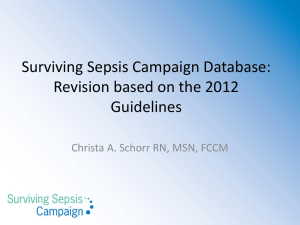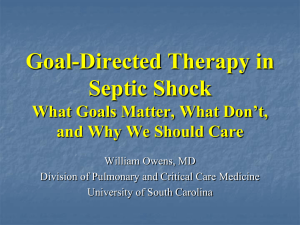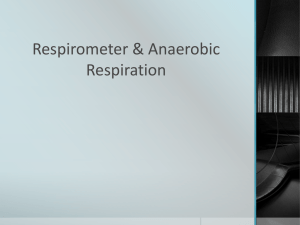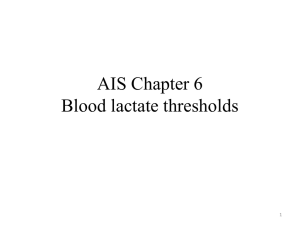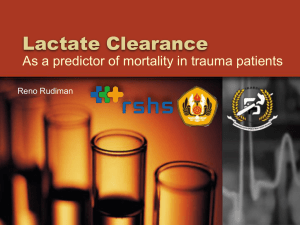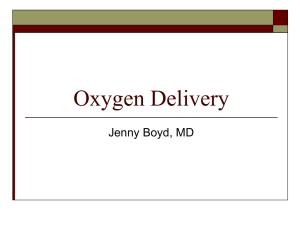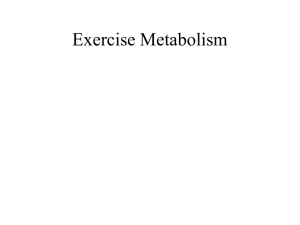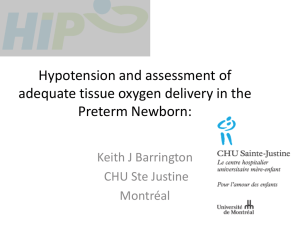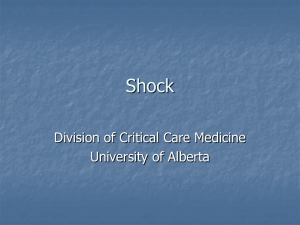webcasts slides - Dellinger
advertisement
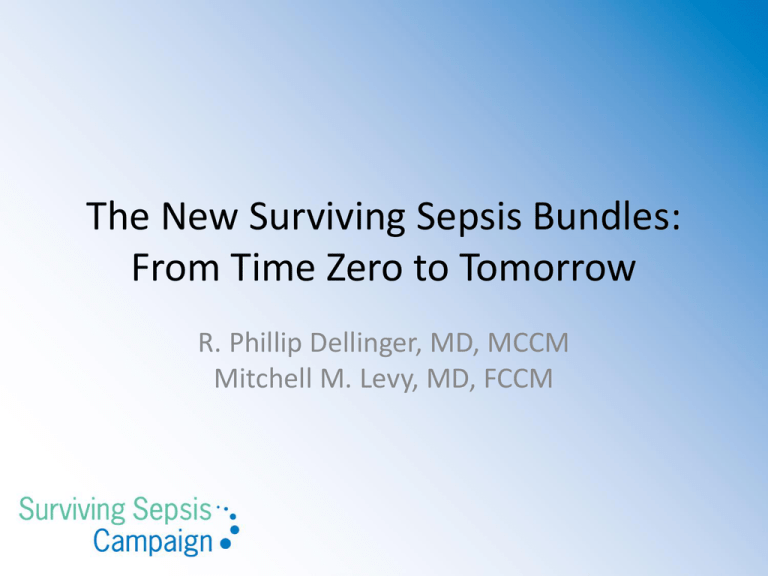
The New Surviving Sepsis Bundles: From Time Zero to Tomorrow R. Phillip Dellinger, MD, MCCM Mitchell M. Levy, MD, FCCM Faculty R. Phillip Dellinger, MD, MCCM Professor of Medicine Cooper Medical School of Rowan University Director, Critical Care Cooper University Hospital Camden, NJ 2004, 2008 & 2012 SSC Guidelines Co-Chair SCCM SSC Steering Committee Past President, SCCM NEW SEPSIS BUNDLES R. Phillip Dellinger MD, MSc, MCCM Professor of Medicine Cooper Medical School of Rowan University Professor of Medicine University Medicine and Dentistry of New Jersey Director Critical Care Medicine Cooper University Hospital Camden NJ USA Potential Conflicts of Interest • No direct or indirect potential financial conflict of interest as to any material presented in this presentation SURVIVING SEPSIS CAMPAIGN BUNDLES TO BE COMPLETED WITHIN 3 HOURS: 1) Measure lactate level 2) Obtain blood cultures prior to administration of antibiotics 3) Administer broad spectrum antibiotics 4) Administer 30 mL/kg crystalloid for hypotension or lactate 4mmol/L TO BE COMPLETED WITHIN 6 HOURS: 5) Apply vasopressors (for hypotension that does not respond to initial fluid resuscitation to maintain a mean arterial pressure [MAP] 65 mm Hg) 6) In the event of persistent arterial hypotension despite volume resuscitation (septic shock) or initial lactate ≥ 4 mmol/L (36 mg/dL): - Measure central venous pressure (CVP)* - Measure central venous oxygen saturation (ScvO2)* 7) Remeasure lactate if initial lactate was elevated* *Targets for quantitative resuscitation included in the guidelines are CVP of 8 mm Hg, ScvO2 of 70%, and normalization of lactate Why measure lactate? Why measure lactate? • Diagnose severe sepsis with elevated lactate as a diagnosis of tissue hypoperfusion • Trigger for quantitative resuscitation if lactate is 4 mg/dL or more SURVIVING SEPSIS CAMPAIGN BUNDLES TO BE COMPLETED WITHIN 3 HOURS: 1) Measure lactate level 2) Obtain blood cultures prior to administration of antibiotics 3) Administer broad spectrum antibiotics 4) Administer 30 mL/kg crystalloid for hypotension or lactate 4mmol/L TO BE COMPLETED WITHIN 6 HOURS: 5) Apply vasopressors (for hypotension that does not respond to initial fluid resuscitation to maintain a mean arterial pressure [MAP] 65 mm Hg) 6) In the event of persistent arterial hypotension despite volume resuscitation (septic shock) or initial lactate ≥ 4 mmol/L (36 mg/dL): - Measure central venous pressure (CVP)* - Measure central venous oxygen saturation (ScvO2)* 7) Remeasure lactate if initial lactate was elevated* *Targets for quantitative resuscitation included in the guidelines are CVP of 8 mm Hg, ScvO2 of 70%, and normalization of lactate Blood Cultures Diagnosis 1. To optimize identification of causative organisms, we recommend at least two blood cultures be obtained before antimicrobial therapy is administered as long as such cultures do not cause significant delay (>45 minutes) in antimicrobial administration, with at least one drawn percutaneously and one drawn through each vascular access device, unless the device was recently (<48 hr.) inserted (Grade 1C). SURVIVING SEPSIS CAMPAIGN BUNDLES TO BE COMPLETED WITHIN 3 HOURS: 1) Measure lactate level 2) Obtain blood cultures prior to administration of antibiotics 3) Administer broad spectrum antibiotics 4) Administer 30 mL/kg crystalloid for hypotension or lactate 4mmol/L TO BE COMPLETED WITHIN 6 HOURS: 5) Apply vasopressors (for hypotension that does not respond to initial fluid resuscitation to maintain a mean arterial pressure [MAP] 65 mm Hg) 6) In the event of persistent arterial hypotension despite volume resuscitation (septic shock) or initial lactate ≥ 4 mmol/L (36 mg/dL): - Measure central venous pressure (CVP)* - Measure central venous oxygen saturation (ScvO2)* 7) Remeasure lactate if initial lactate was elevated* *Targets for quantitative resuscitation included in the guidelines are CVP of 8 mm Hg, ScvO2 of 70%, and normalization of lactate Time to Antibiotics Following Onset Septic Shock Kumar A, et al. Crit Care Med 2006; 34:1589-1596 Antibiotic Therapy We recommend that intravenous antibiotic therapy be started as early as possible and within the first hour of recognition of septic shock (1B) and severe sepsis without septic shock (1C). Remark: Although the weight of evidence supports prompt administration of antibiotics following the recognition of severe sepsis and septic shock, the feasibility with which clinicians may achieve this ideal state has not been scientifically validated. Antibiotic Therapy Initial empiric anti-infective therapy – activity against all likely pathogens and adequate concentrations into suspected or potential sources of infection (1B) Reassess antibiotic regimen daily for deescalation (1B) SURVIVING SEPSIS CAMPAIGN BUNDLES TO BE COMPLETED WITHIN 3 HOURS: 1) Measure lactate level 2) Obtain blood cultures prior to administration of antibiotics 3) Administer broad spectrum antibiotics 4) Administer 30 mL/kg crystalloid for hypotension or lactate 4mmol/L TO BE COMPLETED WITHIN 6 HOURS: 5) Apply vasopressors (for hypotension that does not respond to initial fluid resuscitation to maintain a mean arterial pressure [MAP] 65 mm Hg) 6) In the event of persistent arterial hypotension despite volume resuscitation (septic shock) or initial lactate ≥ 4 mmol/L (36 mg/dL): - Measure central venous pressure (CVP)* - Measure central venous oxygen saturation (ScvO2)* 7) Remeasure lactate if initial lactate was elevated* *Targets for quantitative resuscitation included in the guidelines are CVP of 8 mm Hg, ScvO2 of 70%, and normalization of lactate Fluid therapy 1. Crystalloids (1B) 2. Albumin (2C) 3. Avoid HES (1B) Meta-Analysis Delaney AP, Dan A, McCaffrey J, et al: The role of albumin as a resuscitation fluid for patients with sepsis: A systematic review and meta-analysis. Crit Care Med 2011; 39:386–391 Fluid therapy 4. Initial fluid challenge in sepsis-induced tissue hypoperfusion (hypotension or elevated lactate) with suspicion of hypovolemia to be a minimum of 30ml/kg of crystalloids(a portion of this may be albumin equivalent). More rapid administration and greater amounts of fluid, may be needed in some patients ( 1B) SURVIVING SEPSIS CAMPAIGN BUNDLES TO BE COMPLETED WITHIN 3 HOURS: 1) Measure lactate level 2) Obtain blood cultures prior to administration of antibiotics 3) Administer broad spectrum antibiotics 4) Administer 30 mL/kg crystalloid for hypotension or lactate 4mmol/L TO BE COMPLETED WITHIN 6 HOURS: 5) Apply vasopressors (for hypotension that does not respond to initial fluid resuscitation to maintain a mean arterial pressure [MAP] 65 mm Hg) 6) In the event of persistent arterial hypotension despite volume resuscitation (septic shock) or initial lactate ≥ 4 mmol/L (36 mg/dL): - Measure central venous pressure (CVP)* - Measure central venous oxygen saturation (ScvO2)* 7) Remeasure lactate if initial lactate was elevated* *Targets for quantitative resuscitation included in the guidelines are CVP of 8 mm Hg, ScvO2 of 70%, and normalization of lactate Resuscitation of Sepsis Induced Tissue Hypoperfusion • Recommend MAP 65 mm Hg Grade 1C Vasopressors During Septic Shock Diastole Systole 10 Days Post Shock Diastole Systole 28-day Survival De Backer D, et al. N Engl J Med 2010, 362;9:779-789 Predefined subgroup analysis by type of shock De Backer D, et al. N Engl J Med 2010, 362;9:779-789 Meta-analysis – NE versus dopamine Crit Care Med. 2012 Mar;40(3):725-30 Vasopressors Front line: (1) Norepinephrine (1B). (2) Epinephrine (2B) Vasopressin .03 units/min (UG) Vasopressors • In general avoid – Dopamine, unless • Relative or absolute bradycardia and low risk of tachyarrhythmias (2C) – Phenylephrine, unless • Norepinephrine associated with serious arrhythmias • Cardiac output is known to be high and blood pressure target difficult to achieve • As salvage therapy (1C) Sepsis Induced Tissue Hypoperfusion Requirement for vasopressors after fluid challenge Lactate ≥ 4 mg/dL Quantitative Resuscitation Critical Care Medicine. 36(10):2734-2739 Protocolized Care SURVIVING SEPSIS CAMPAIGN BUNDLES TO BE COMPLETED WITHIN 3 HOURS: 1) Measure lactate level 2) Obtain blood cultures prior to administration of antibiotics 3) Administer broad spectrum antibiotics 4) Administer 30 mL/kg crystalloid for hypotension or lactate 4mmol/L TO BE COMPLETED WITHIN 6 HOURS: 5) Apply vasopressors (for hypotension that does not respond to initial fluid resuscitation to maintain a mean arterial pressure [MAP] 65 mm Hg) 6) In the event of persistent arterial hypotension despite volume resuscitation (septic shock) or initial lactate ≥ 4 mmol/L (36 mg/dL): - Measure central venous pressure (CVP)* - Measure central venous oxygen saturation (ScvO2)* 7) Remeasure lactate if initial lactate was elevated* *Targets for quantitative resuscitation included in the guidelines are CVP of 8 mm Hg, ScvO2 of 70%, and normalization of lactate Initial Resuscitation of Sepsis Induced Tissue Hypoperfusion Recommend Insertion central venous catheter Recommended goals : • Central venous pressure: 8–12 mm Hg • Higher with altered ventricular compliance or increased intrathoracic pressure • ScvO2 saturation (SVC) 70% Grade 1C Limitation of pressure measurement to predict fluid responsiveness Arterial Systolic Pressure Variation Parry-Jones, et al. Int J Respir Crit Care Med 2003;2:67 Effect on Cardiac Filling Effect on Stroke Volume Part A t Effect on Stroke Volume SURVIVING SEPSIS CAMPAIGN BUNDLES TO BE COMPLETED WITHIN 3 HOURS: 1) Measure lactate level 2) Obtain blood cultures prior to administration of antibiotics 3) Administer broad spectrum antibiotics 4) Administer 30 mL/kg crystalloid for hypotension or lactate 4mmol/L TO BE COMPLETED WITHIN 6 HOURS: 5) Apply vasopressors (for hypotension that does not respond to initial fluid resuscitation to maintain a mean arterial pressure [MAP] 65 mm Hg) 6) In the event of persistent arterial hypotension despite volume resuscitation (septic shock) or initial lactate ≥ 4 mmol/L (36 mg/dL): - Measure central venous pressure (CVP)* - Measure central venous oxygen saturation (ScvO2)* 7) Remeasure lactate if initial lactate was elevated* *Targets for quantitative resuscitation included in the guidelines are CVP of 8 mm Hg, ScvO2 of 70%, and normalization of lactate Lactate Clearance In patients with elevated lactate levels as a marker of tissue hypoperfusion we suggest targeting resuscitation to normalize lactate as rapidly as possible (grade 2C). www.survivingsepsis.org Thank You QUESTIONS?
